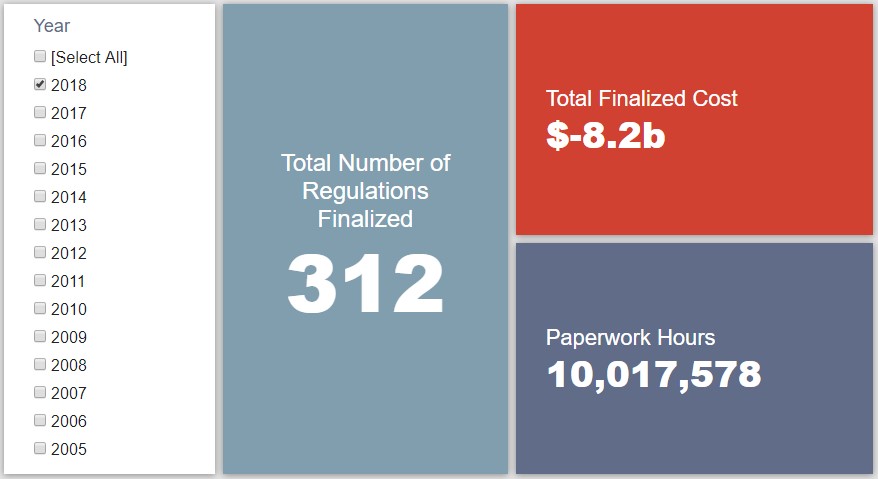Week in Regulation
December 26, 2018
A Late December Regulatory Surge
As the end of 2018 approaches, the pages of the Federal Register saw a notable spurt in regulatory burdens. A Department of Agriculture (USDA) rule regarding bioengineered food disclosures led the flurry of cost-increasing rulemakings. Although, as discussed below, that rule’s impact could vary wildly depending upon the baseline assumptions. Between both proposed and final rules last week, agencies published $5.6 billion in net costs, and increased paperwork by 20.5 million hours. The per capita regulatory burden for 2018 is negative $24.88.
REGULATORY TOPLINES
- New Proposed Rules: 46
- New Final Rules: 82
- 2018 Total Pages of Regulation: 65,781
- 2018 Final Rules: -$8.2 Billion
- 2018 Proposed Rules: -$545.7 Billion
TRACKING REGULATORY MODERNIZATION
The most significant rulemaking of the week was USDA’s “National Bioengineered Food Disclosure Standard.” The rule establishes “a mandatory uniform national standard for disclosure of information to consumers about the BE [bioengineered] status of foods” and USDA estimates that it could impose up to $391 million in annualized costs (or nearly $5.6 billion in present value using a 7 percent discount rate). Such an estimate actually throws the administration-wide fiscal year (FY) 2019 regulatory budget under Executive Order (EO) 13,771 into the net cost column. However, this hinges upon how one accounts for the baseline.
The net-cost estimate is based upon “a baseline in which there are no requirements for the labeling of food containing bioengineered foods or ingredients.” As USDA goes on to discuss, the rule would preempt – in a deregulatory manner – the imposition of Vermont’s state-based standard from becoming the de facto national standard. This yields $77 million in annual savings (or $1.1 billion in present value using a 7 percent discount rate). In the proposed version, USDA was ambiguous about the rulemaking’s status under EO 13,771. While this savings estimate is included in the rule’s discussion of the EO, there does not appear to be a definitive declaration of the rule’s status; its categorization here is “Other.” Thus, the caveat that: for the purposes of RegRodeo, we have included the net-cost estimate, but it could be a net-savings rule under the administration’s EO 13,771 accounting as well. Such a shift would constitute a $6.7 billion swing.
So far in FY 2019, there have been 21 deregulatory actions (per the rubric created by EO 13,771 and the administration’s subsequent guidance document) against eight rules that increase costs and fall under the EO’s reach. Combined, these action yield quantified net costs of roughly $1.1 billion. This, however, includes the caveat regarding the baseline in USDA’s “National Bioengineered Food Disclosure Standard.” If one considers that rule to actually be deregulatory, the administration-wide net total is approximately $5.6 billion in net savings. The administration’s cumulative savings goal for FY 2019 is approximately $18 billion.
STATE OF MAJOR OBAMA-ERA INITIATIVES
Based on total lifetime costs of the regulations, the Affordable Care Act has imposed costs of $52.9 billion in final state and private-sector burdens and 176.9 million annual paperwork hours.
Since passage, the Dodd-Frank financial reform legislation has produced more than 82.9 million final paperwork burden hours and imposed $38.9 billion in direct compliance costs.
TOTAL BURDENS
Since January 1, the federal government has published $553.9 billion in net cost savings (with $8.2 billion in net savings from final rules) and paperwork burdens amounting to roughly 26.4 million hours (including 10 million hours of new paperwork under final rules). Click here for the latest Reg Rodeo findings.











